A Roadmap for Campus Decarbonization
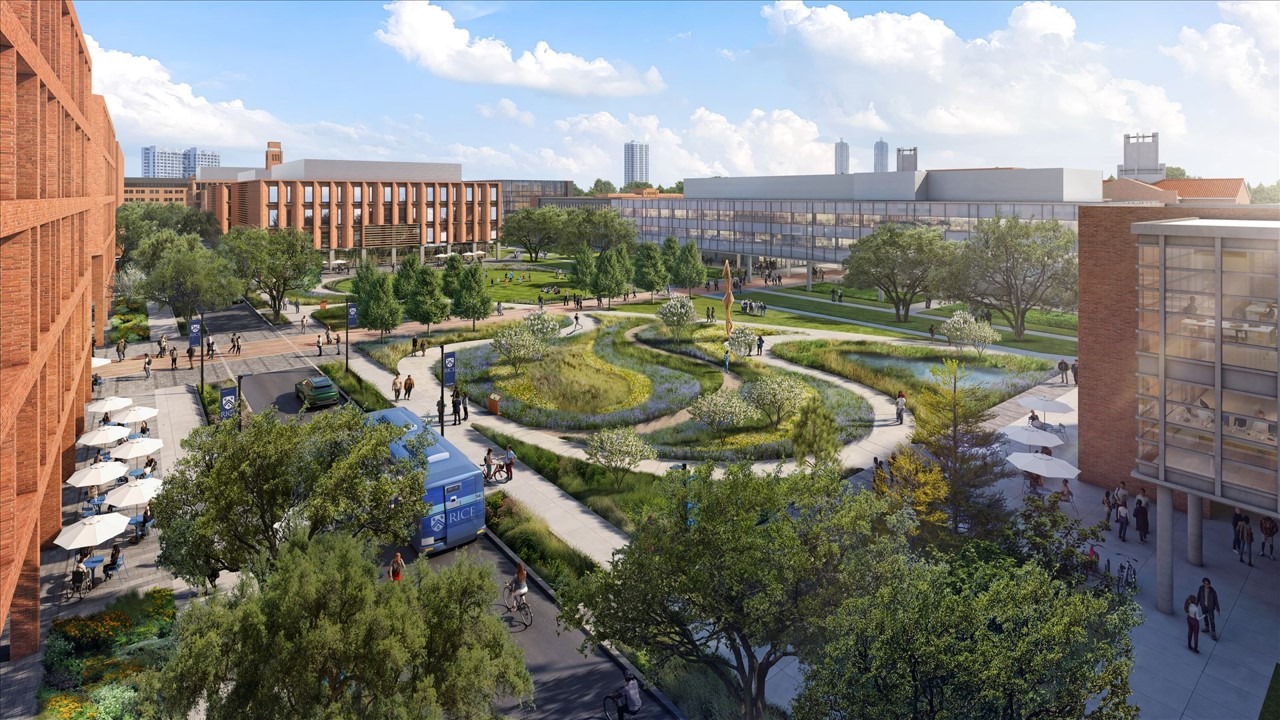
 Sasaki
Sasaki

Campuses have always been a laboratory for urban design excellence in America— and the same is true for climate action. Colleges and universities are at the forefront with carbon neutrality commitments, and Sasaki has worked with over a dozen campus clients to modernize energy infrastructure and reduce emissions from their operations, both for fiscal and environmental responsibility.
Campuses are uniquely situated for the transformations required for shifting from fossil fuels to clean and renewable energy sources, including electrification and renewable power, either generated on-site or purchased offsite. Most rely upon central utility plants powered by fossil fuels to provide heating and cooling. Their dedicated staff work to maintain campus infrastructure and buildings, with detailed knowledge of system strengths and vulnerabilities. Most of all, campuses are long-term stewards of their assets and resources who are committed to operating and maintaining their institutions for decades and centuries to come—and to using the campus itself as a living laboratory for sustainability education and research.
Solutions for each client emerge from their unique combination of motivations, site conditions, budgets, and jurisdiction requirements. At Rice University, carbon neutrality targets originated with leadership strategic goals, including the foundational principle for education and research for “designing sustainable futures.” Emory University aimed to reduce energy use by 50 percent, to reduce emissions and operational costs. For public universities in Minnesota, Rhode Island and Massachusetts, funding involves compliance with State Executive Orders mandating carbon neutrality by 2050 – while continuing to increase programs and enrollment.
Though each campus is its own complex ecosystem, Sasaki has developed a roadmap that can be tailored for each institution, adapting it to align with strategic plans and physical constraints.

Tamar leads a workshop with university and facilities leaders at Rice University.
Phase 1 analysis begins with existing conditions and resource use, exploring energy sources and uses, carbon emissions, central plants and distribution networks, condition of facilities and infrastructure, and the capacity of these systems to support future campus strategic goals and growth projections.
We facilitate workshops with all campus stakeholders to identify and rank priorities, explore drivers, challenges, opportunities and strategies that are applicable to their campus. In-person interactive workshops are particularly valuable to integrate facilities management, plant engineers and operators, and key operations and maintenance staff with academic leaders, financial and administration managers and sustainability professionals, to ensure that all voices and perspectives are heard, and all ideas are tested for viability.
In parallel, we survey buildings with the highest energy use to prioritize strategic renovation funds for the most effective energy reductions. We explore land uses and opportunity sites on campus – most effective when we are involved in decarbonization planning and the broader campus plan – including buildings, landscape and infrastructure, and sites for new central plants, solar PV, and geothermal bore fields.
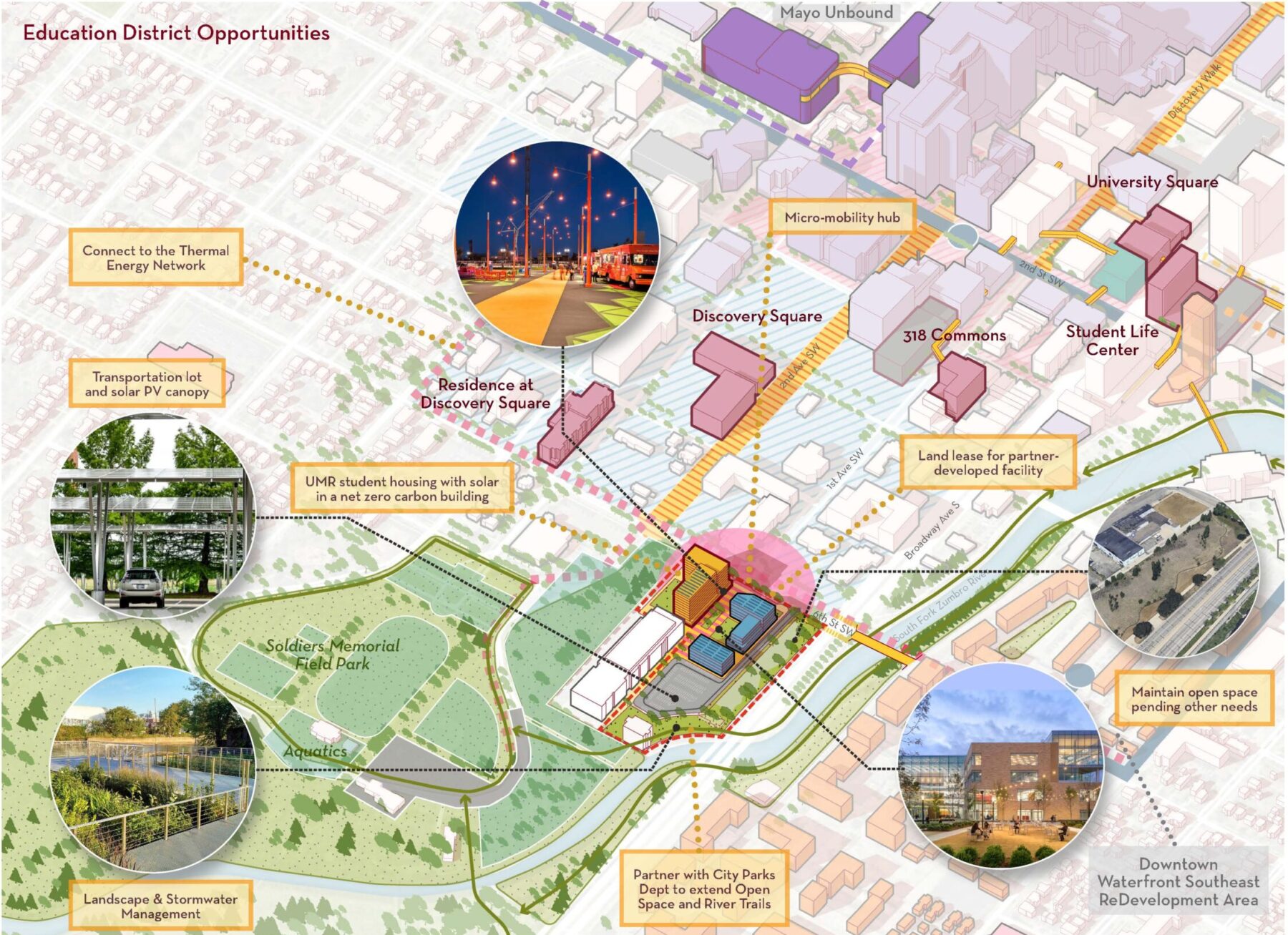
Our team found opportunities at the University of Minnesota Rochester that would help the campus reach its goals, including through partnerships.
Each university’s challenges pose unique opportunities. Rice University had been spending valuable resources on simultaneous heating and cooling. Emory’s program renovations could incorporate energy efficiency measures. And for the University of Minnesota, athletic fields offered ideal sites for underground geowells for ground source heat pumps.
Through a series of in-person, interactive workshops, we work with client stakeholders to explore alternative design scenarios, including electrification of the heating plant, thermal distribution networks, and necessary building conversions. Through hands-on workshops, we engage stakeholders to evaluate alternative options, reviewing impacts on campus budget, operations, disruption, resilience, emissions and strategic goals.
Stakeholders reduce the number of alternative scenarios from six to three to one preferred option for further development. At each stage, construction cost estimates become more detailed, from Rough Order of Magnitude estimates to full Life Cycle Cost Analysis.

University of Minnesota Crookston heating systems
In parallel, we address campus-wide energy issues, including metering and building management systems, renewable energy procurement onsite, or offsite with a third party or a virtual PPA.
We explore the related issues of campus water balance, considering domestic water use, irrigation, and process water use. Many electrification strategies do not require cooling towers and can yield significant savings in water use. At Rice, fuel switching allowed us to cut process water by 90 percent, which can save the University $250,000 per year in water costs. And at Emory, we found that condensate water could be harvested to meet the irrigation needs of the beautifully landscaped campus.
For each project, cost estimates incorporate incentive programs at the local, state, and federal level, as well as alternative procurement possibilities including Energy Service Companies (ESCOs) and Power Purchase Agreements (PPAs).
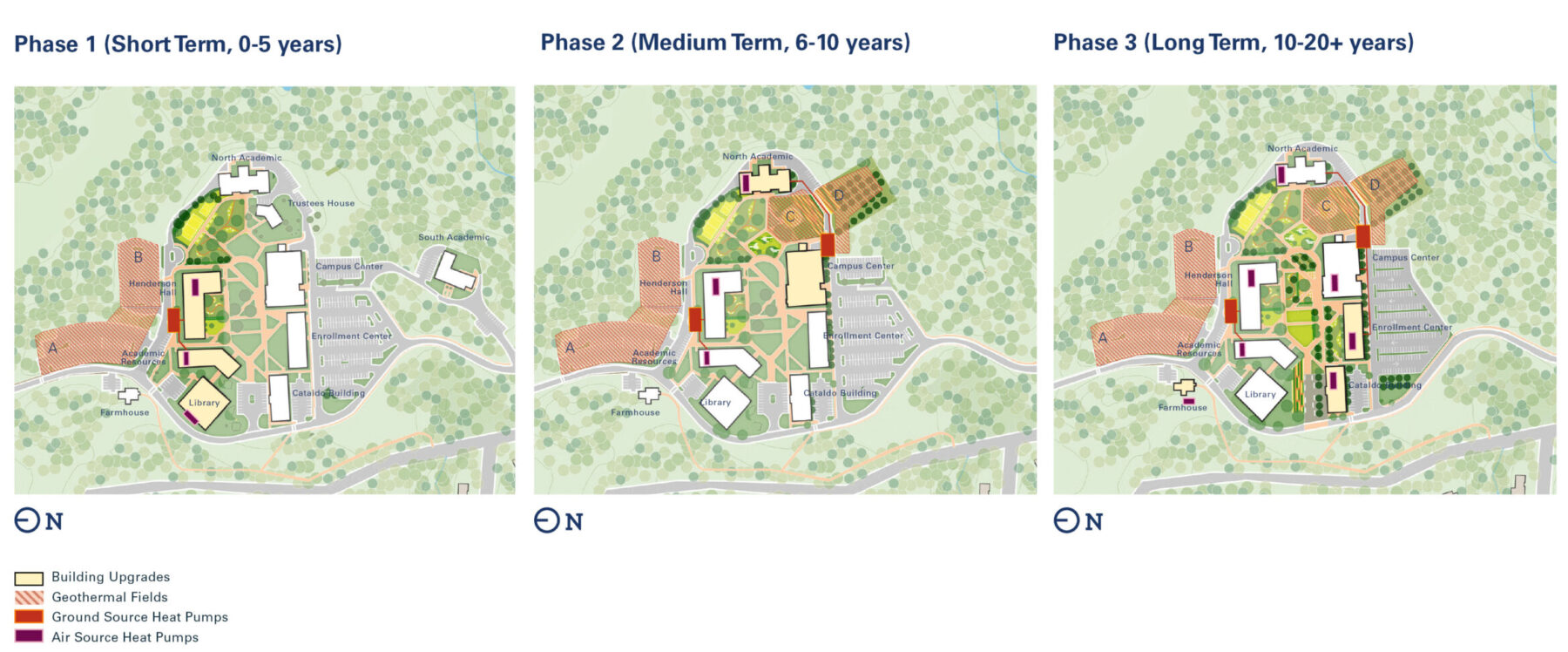
Proposed implementation plan for Middlesex Community College’s Bedford campus
In Phase 3, we work with the stakeholders to detail the implementation of the selected option, including new central or district plants, distribution systems and any necessary building conversions. We address resilience concerns through discussions about added capacity and batteries or thermal energy storage systems.
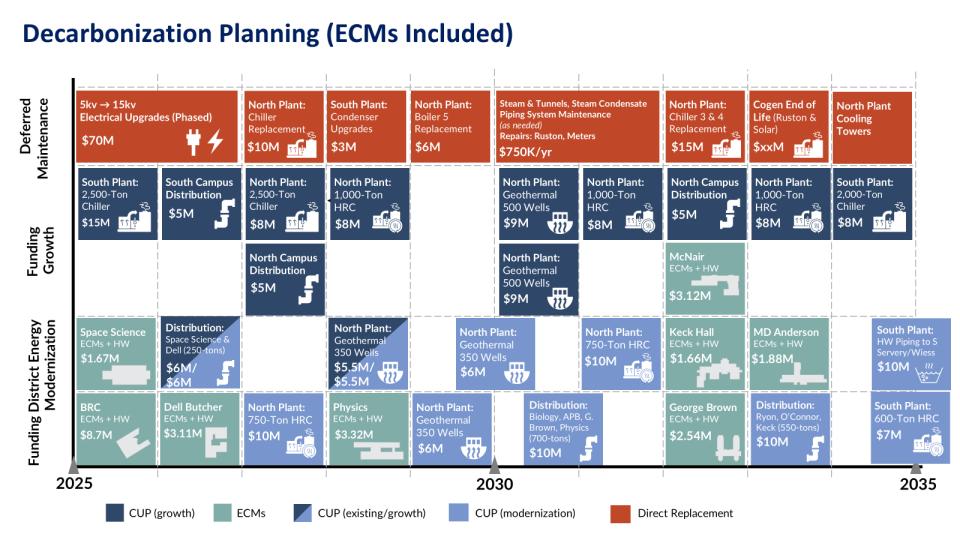
Planning for Rice University
We develop an implementation plan with phasing, budgets, and emission reductions that align with client goals and resources. Using Dashi, our in-house dashboard for decarbonization, we can visualize alternative implementation scenarios to help senior leadership understand the impacts of alternate scenarios on campus space planning, budgets, and carbon emissions.
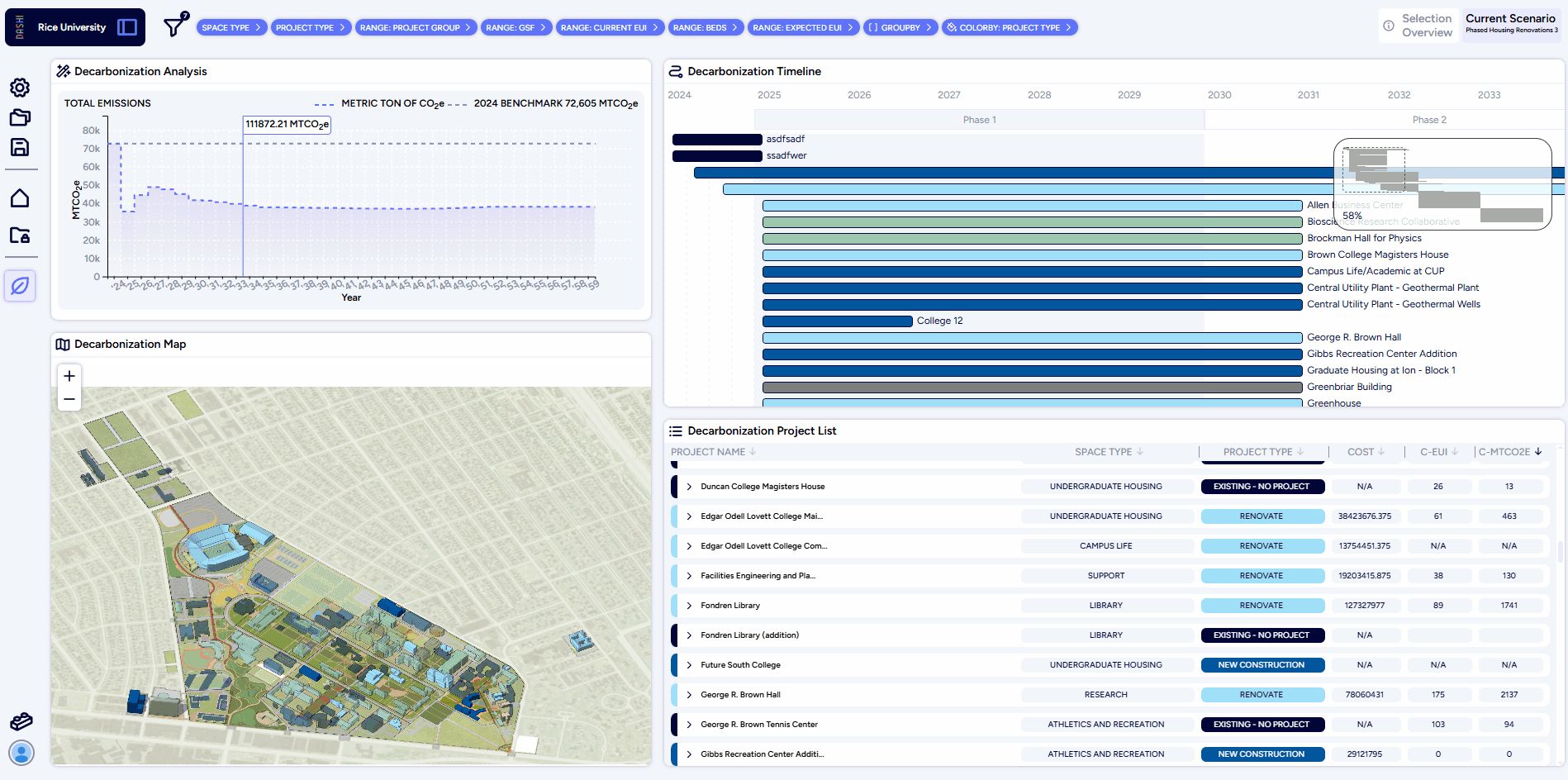
Dashi, a tool developed by Sasaki, helps make long-term planning decisions easier.
To transition to implementation, we also develop Sustainability Design Guidelines with key targets and strategies to be used for all future capital improvement projects, setting clients up for success in realizing their sustainability and climate action goals.
For Rice University, the selected solution was a networked four-pipe system of hot water and chilled water. Massachusetts Maritime Academy preferred an ambient loop. At Northeastern University and University of Rhode Island, the selected solution is a hybrid of district technologies, with historic buildings remaining on an existing plant that is electrified more gradually, while outlying districts with higher-energy uses such as laboratory buildings shift to geothermal loops or standalone air-source heat pumps. Each client, context, budget and schedule calls for a unique solution.
Decarbonizing campuses requires an integrated approach that considers the many layers of campus strategic vision, program goals, facilities management, capital planning, and operations and maintenance. Sasaki’s decarbonization portfolio represents our holistic approach to energy transition projects based on fiscal and environmental responsibility. Our team applies our knowledge of complex campus systems, developed over decades of working within higher education, to help clients realize their stewardship goals for resilient, flexible, future-forward, and sustainable future.